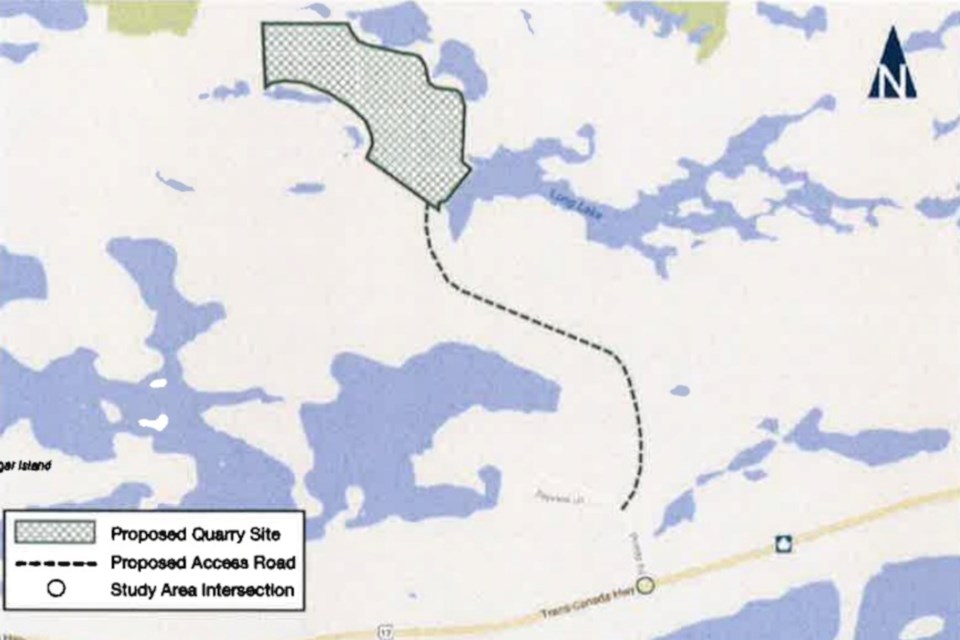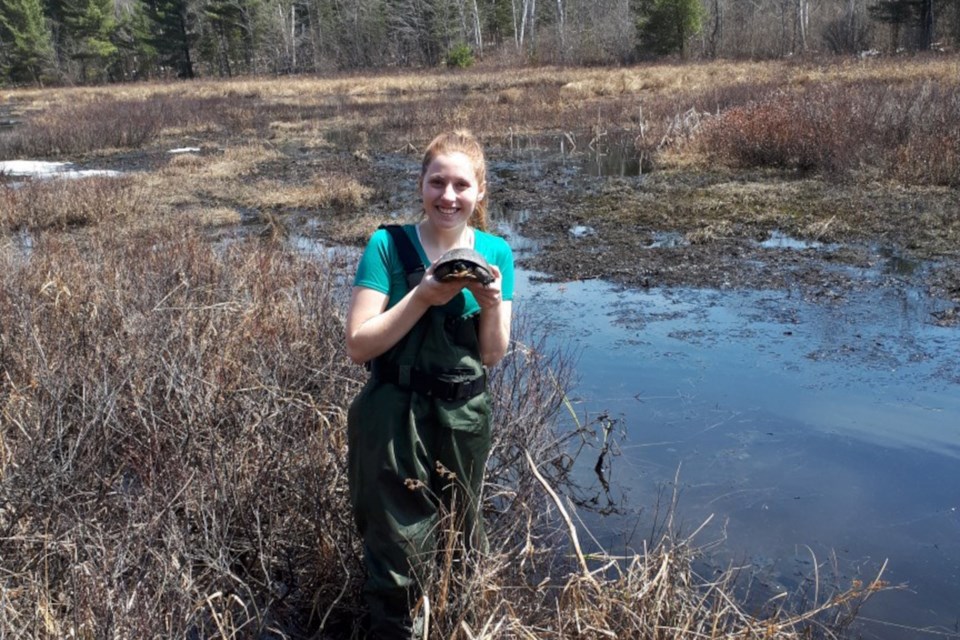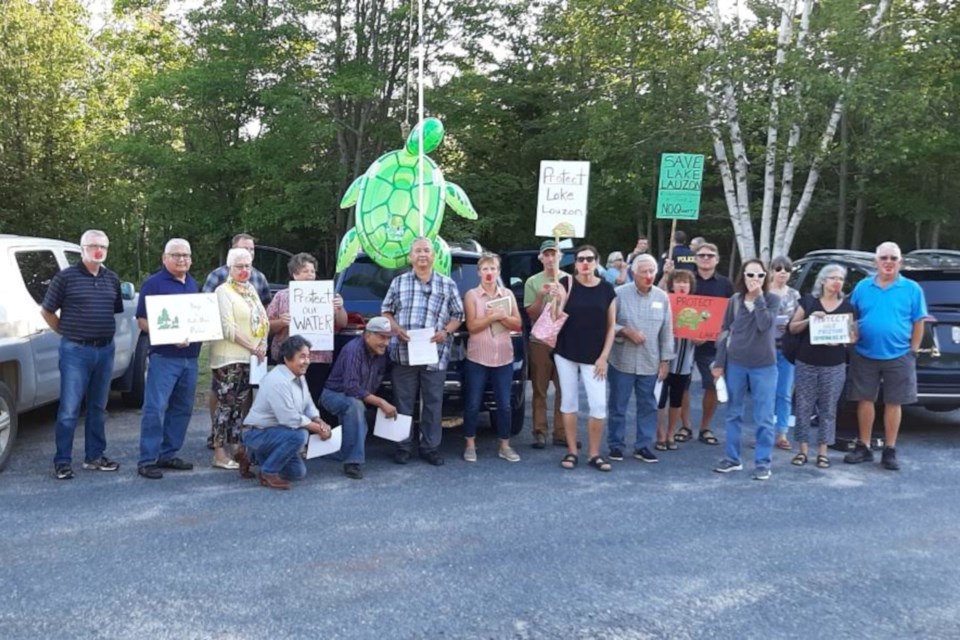A contested quarry in Township of the North Shore is threatening a dense collection of threatened Blanding's turtles, according to a group of environmentalists and researchers.
Student researchers have referred to the wetlands that surround the proposed quarry as “the honey pot” when it comes to threatened/endangered Blanding's turtles.
(They’re “threatened” under the Ontario Endangered Species Act and “endangered” under the federal Species at Risk Act.)

“Almost every time we come here, you’re guaranteed to catch a turtle, which is pretty unheard of for Blanding's turtles,” student researcher Heather Van Den Diepstraten said in a video produced by the Wilderness Committee highlighting their opposition to the quarry.
“Although the wetlands surround the quarry site, the rock and forested area is still part of their nesting area,” Wilderness Committee Ontario campaigner Katie Krelove told Sudbury.com, noting that researchers have found nesting sites on the proposed quarry site.
Including buffers around known nesting sites, she said much if not all of the quarry site is “critical habitat” for the turtles.
In a 2019 paper by Laurentian University researchers published in the Global Ecology and Conservation journal, they report capturing 56 turtles and a density of 1.84 turtles per hectare, “which is among the highest reported densities for the species.”
“Daily distances moved and home range sizes were generally smaller than conspecific (a member of the same species) values reported in the literature, suggesting that habitat quality was high as turtles did not need to move much to acquire necessary resources,” their abstract notes.
The researchers mapped 15 nesting sites and 12 wetlands that house overwintering turtles and paired it against provincial and federal guidelines. The results dictate at least 63 per cent and as much as 100 per cent of the proposed quarry area is an endangered species habitat, according to the report.
“The results indicate that the quarry proposal should be rejected if the spirit of the law is upheld,” the report’s authors note.

The Wilderness Committee is currently writing a request to federal Environment and Climate Change Minister Steven Guilbeault requesting the government intervene by recommending an emergency order to protect the Blanding’s turtles.
“It has not yet been submitted, but emergency orders are one way for the federal government to intervene to protect known endangered species not in federal jurisdiction,” Krelove said.
The development might also have broader implications for the balance of the province, as the current provincial government has set up a system which favours developers and lends little credence to environmental concerns, North Shore Environmental Resource Advocates Inc. president Rhonda Kirby told Sudbury.com.
Her group and other environmental organizations, such as Reform Gravel Mining Coalition, are pushing for a moratorium on new quarries until related concerns are dealt with.
Many of their assertions are supported by the Office of the Auditor General of Ontario, whose report, “Value-for-Money Audit: Management of Aggregate Resources,” shines a light on various perceived shortcomings in the province’s handling of quarries.
“There’s very little recourse for environmental groups, and even municipalities, to deal with this,” Kirby told Sudbury.com, adding that this is why her and other environmental groups are calling for the moratorium.
“Put the brakes on, a pause to ensure the recommendations that were suggested by the auditor general are put into place, because something needs to change,” she said. “It’s an industry that has carte blanche to do whatever the hell they want.”
To her immediate concern is a quarry proposed by Darien Aggregates Inc., to take shape on 115.38 hectares of Crown Land, including a total extraction area of 68.31 hectares. The quarry has been estimated to last 120-150 years, according to a Township of the North Shore report.
The property is located north of the eastern edge of Lauzon Lake, whose centre is north of Algoma Mills, several kilometres east of Blind River. The property’s eastern edge hugs Long Lake, and there are numerous wetlands in the area.
Kirby’s residential property is 1.4 kilometres away from the edge of the proposed quarry, and while she said her neighbourhood may be affected by the development, the environment is top of mind in her opposition.
“Wetlands serve a purpose,” she said. “They hold a real place in the ecosystem. They filter water, they provide habitat for all of these threatened species, and they really need to be protected.”
Darien Aggregates Inc. applied for a Category 12 Aggregate Permit in 2016, and has been going through the process to get the quarry operational ever since.
Despite opposition from Kirby’s group, North Shore council of the day greenlit a zoning amendment to accommodate the project on Nov. 5, 2019, with a vote of 3-2.
It’s now in the province’s hands, which has yet to make a final decision.
In the event the quarry were to come in, Kirby said, “They’ll go in and clean the whole top of it off. All that soil and the topography will be gone.”
Between the quarry’s anticipated lifespan of more than a century and the province’s existing record for reclamation, she said it’s difficult to say when or even if it will ever be rehabilitated.
Then, there are the issues raised by the Office of the Auditor General of Ontario in their Management of Aggregate Resources value-for-money audit.
“Aggregates — sand, gravel, clay, stone and rock — are essential for building much of Ontario’s infrastructure, including highways, hospitals, schools and houses,” the auditor’s report notes.

“However, when these natural materials are extracted from the earth’s surface, they can fundamentally transform landscapes, temporarily or permanently altering features such as woodlands, wetlands and farmland.”
Some of the auditor’s key findings were:
- Quarry operations are rarely visited, with only 35 per cent of sites the office reviewed having been inspected within the previous five years.
- Rates of non-compliance are high, with 36 to 52 per cent of sites visited from 2018 to 2022 deemed compliant. Inspectors rarely refer cases of non-compliance for further enforcement. In cases where operators exceeded extraction limits by more than 1,000 per cent, the ministry did not investigate or charge the operator.
- The ministry doesn’t enforce penalties for aggregate operators who filed to submit a self-compliance report on time, or at all.
- The ministry doesn’t have processes in place to ensure sites are rehabilitated after extraction is complete.
- The ministry needs better information on the supply of aggregates.
“Limited inspection and enforcement, and the lack of experienced inspectors, means that the Province is not doing enough to maintain a balance between the need for aggregates for Ontario’s growing population, and the need to minimize the impacts of aggregate operations on the environment and communities,” acting Auditor General Nick Stavropoulos said in a media release last month.
In the provincial government’s ongoing push to eliminate so-called “red tape” under Premier Doug Ford’s government, they’ve made it easier for quarries to get pushed through with minimal oversight, Kirby contends.
“It made what was already a very easy process for a proponent to achieve a permit or a licence even easier,” she said. “They’ve just streamlined the entire process.”
Sudbury.com sent an inquiry to a provincial spokesperson requesting a phone interview to help address quarry-related concerns expressed by environmental advocates and the auditor general’s office.
The request for an interview was not addressed in their response.
Instead, a written statement was provided in which they note technical reports must support quarry applications, including those which address potential environmental impacts.
They are also expecting an aggregate supply and demand study for the Greater Golden Horseshoe area within the next few months.
(Reform Gravel Mining Coalition contends that the province has more than enough quarries, and has already authorized the gravel mining industry to extract 13 times more gravel each year than is required to meet the average annual consumption.)
The Darien Aggregates Inc. proposal in North Shore is currently at the “Public Notice” stage, and no decision has been made, the provincial spokesperson noted.
“The applicant is addressing public and agency input, completing the Class EA RSFD (an environmental assessment), and fulfilling Indigenous community consultations,” the spokesperson noted. “Mitigation measures from technical reports and proposed solutions for raised concerns have been added to site plans.”
They will need to meet Aggregate Resources Act requirements in their final consultation package, which is due Feb. 27, and fulfill environmental assessment requirements before the province makes a decision on whether to approve the quarry application.
Sudbury.com left a message with Darien Aggregates Inc., but our request for comment was not returned.
Although Kirby said she has become pessimistic about her group’s ability to prevent the quarry from going in at North Shore, she’s hopeful their efforts, and those of such groups as Reform Gravel Mining Coalition, inspire a push to impose a moratorium on new quarries.
The hope, she said, is to allow time for the province to develop a broader consultation process which includes affected communities and addresses the auditor’s findings.
For a map of existing pits and quarries, click here.
Tyler Clarke covers city hall and political affairs for Sudbury.com.
